1939
_______________________________
–FLASHBACK: From Secret Origins Vol. 2 #6. January to March 1939. Bruce continues his studies at Gotham University. He also continues happily dating Julie Madison. In the early spring of 1939, Bruce and Julie see the Humphrey Bogart film Invisible Stripes. Bruce is particularly struck by its depiction of the criminal mind. (Of course, in real life, Invisible Stripes wasn’t released until December of 1939, but oh well.)
–FLASHBACK: From Batman #96 Part 2. March to early May 1939. Bruce, naturally a star collegiate athlete, earns the continued wrath of his arch-rival Joe Danton. Danton already had beef with Bruce dating back to the wrestling and football seasons (September to November 1938), but now the baseball coach benches Danton in favor of Bruce, angering Danton further. Shortly thereafter, Bruce and Danton duel in a fencing match. During the match Danton purposefully strikes an unprotected part of Bruce’s arm, giving him a nasty permanent scar. The fencing coach kicks Danton off the team. Later, Danton swears that he will one day get revenge on Bruce and the rest of the team.
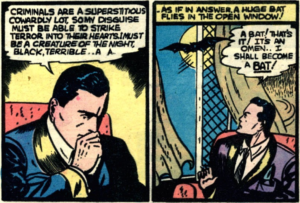
Detective Comics #33 by Bill Finger, Gardner Fox, Bob Kane, & Sheldon Moldoff (1939)
–FLASHBACK: From Secret Origins Vol. 2 #6 Part 1. Early May to early June 1939. Bruce (age 24) and Julie graduate from college.[1] The lovers immediately turn their relationship into a distanced one as Julie moves from Gotham to New York City to pursue a career in acting. Weeks pass, during which Bruce broods in his penthouse apartment, thinking only of how to avenge the deaths of his parents. In the final days of May, Bruce sits in his home and ponders about what to wear while undertaking his vigilante mission, saying aloud, “Criminals are a superstitious cowardly lot, so my disguise must be able to strike terror into their hearts.” As if by fate, a bat flies in through the window, thus inspiring Bruce to become the Dark Knight of Gotham, the Bat-Man. (Yes, he is originally called “The Bat-Man,” but for brevity’s sake I will refer to him simply as “Batman.” He will also be referred to by various nicknames, including “Dark Knight,” “Caped Crusader,” “Dark Detective,” “Masked Manhunter,” and “World’s Greatest Detective.”) As we learn in Detective Comics #235, Bruce, when making the decision to become the Dark Knight, also subconsciously recalls a Batman costume his father wore at a masquerade when he (Bruce) was four-years-old, although he won’t realize this for a long time. The backstory regarding the death of the Waynes and/or the pivotal scene where the bat flies through the window are also shown through flashback from Detective Comics #33, Batman #1 Prelude, Batman #47 Part 3 Intro, Detective Comics #190, Batman #94 Part 1, and Detective Comics #235. Donning a disguise, Bruce meets with tailors in a hotel and has them design the Bat-costume for him (sans gloves). As referenced in Detective Comics #29, Bruce stores his costume in a trunk in his bedroom. (He will later store his costumes both in his bedroom and in the Bat-Bunker). Bruce designs his own utility belt, complete with crime fighting accoutrements. He will constantly replenish and update the belt. As referenced in Detective Comics #265, Bruce also makes special gauntlet gloves (with fins) to go with his Bat-costume. Batman’s first night on patrol is shaky and full of near fatal mistakes, but the rookie vigilante manages to nab gangster Slugsy Kyle and leave him tied up for the police complete with a note. (The Kyle sequence in Secret Origins Vol. 2 #6 Part 1 is a panel-for-panel reshowing of an original flashback from Detective Comics #265. A flashback from Batman #47 Part 3 Intro also shows Batman on his first night out.) After leaving Kyle tied-up for the police, Batman considers abandoning his costumed vigilante idea altogether, bothered by both his mistakes in the field and the fact that his costume didn’t scare the burglar. Bruce ponders if he should just apply for a police desk-job after all. He calls Julie, saying he has something he wants to speak to her about in person, though it’s pushed back until tomorrow afternoon due to her rehearsals. The next day, Bruce is still plagued with doubts about his mission. He decides that he will move from Gotham to New York City and ask Julie to marry him. Bruce then sets up a meeting with an old friend of his deceased Uncle Philip Wayne, GCPD Commissioner James Gordon. Bruce hopes to obtain a recommendation for the NYPD from Gordon.
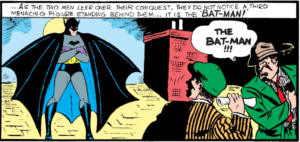
Detective Comics #27 by Bill Finger & Bob Kane (1939)
–Detective Comics #27
Bruce meets with GCPD Commissioner James Gordon. Bruce and Gordon both indulge in a shared favorite pastime of smoking tobacco and briefly discuss the mysterious Batman. Before Bruce can even talk about the idea of police-work in NYC, Gordon gets an urgent call about an investigation. Bruce immediately accompanies Gordon to a crime scene where industrial tycoon David Lambert has been murdered. Batman makes his second appearance at the home of Lambert’s business partner Steven Crane. (Probably still trying to figure out what works best, Batman has ditched his blue gauntlet-fin gloves and is now wearing small purple gloves.) Batman is unable to prevent Crane’s murder. However, Bruce does take out the killers and retrieves an important clue as to who hired them: a business contract. Lambert’s third business partner, Paul Rogers, hears of the murders and flees to Lambert’s fourth and final partner, Alfred Stryker. At Stryker’s home Batman shows up just in time to save Rogers’ life from the mastermind of the vile plot; Stryker, who falls to his death while struggling with the Caped Crusader. Batman had learned from the contract that Stryker stood to gain complete control of Apex Chemicals if his three other partners died. Afterward, Bruce and Gordon chat again. (The aptly named “Case of the Chemical Syndicate” is also retold through flashback from Secret Origins Vol. 2 #6 Part 1, which notably highlights Batman’s sleek 1939 roadster—a precursor to the Batmobile. This item is also shown via an iconic ‘tec #27 cover-copying flashback from Detective Comics #500 Part 1.)
–FLASHBACK: From Secret Origins Vol. 2 #6 Part 1. Immediately after returning home after the “Case of the Chemical Syndicate,” Bruce phones Julie in New York and puts her at ease by telling her that he will not pursue his dream to become a policeman. Of course, he doesn’t tell her that he has instead become the Batman. (Presumably, Bruce officially takes on his role as head of Wayne Enterprises at this juncture.)
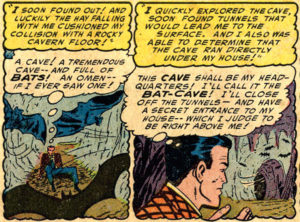
Detective Comics #205 by Bill Finger, Sheldon Moldoff, & Charles Paris (1954)
–FLASHBACK: From Detective Comics #205. Bruce, with costumed vigilantism plans now firmly in mind, purchases and moves to a remote location just outside of Gotham. This palatial mansion estate, which Bruce dubs “Wayne Manor,” will be his primary residence for the rest of his life. Intending to use a barn on the edge of the property as his vigilante HQ, Bruce actually winds up falling through the earth, discovering a large cavern that runs beneath the entire property. After quickly drafting blueprints and completing prep work, Bruce immediately begins construction in this cavern, building an underground bunker HQ that will eventually include a training gym, garage, medical bay, crime lab, and all the equipment and space needed to invent lots of new stuff. As we learn in Batman #64, the caves below Wayne Manor are linked via a maze of natural underground passageways to the historic Anderson Caves that run for miles underground. The Anderson Caves were last inhabited by enslaved Black runaways and Confederate spies during the Civil War. The actual cavern under the Wayne property itself was used as a hideout for lawman Jeremy Coe in the 1650s (as we learn in Detective Comics #205). Note that, while the flashback from ‘tec #205 refers to Batman’s underground HQ as the “Bat-Cave” right away, Batman won’t actually expand his bunker into the rest of the cave until Year Six. Thus, he doesn’t actually use the word “Bat-Cave” until that time. Note that keeping the Bat-Bunker hidden is no small task, especially since it is connected to publicly-known geologically surveyed caves. We must assume that, aside from sophisticated security and camouflaging methods, Batman uses his vast resources to erase geological history records in order to keep this secret safe. He likely will utilize false seismic echo generators to fool radio frequencies and ground-penetrating radar too. Also note that Batman will be constructing his underground lair for years to come—this thing doesn’t happen completely overnight.
–REFERENCE: In World’s Finest Comics #39 and The Brave and The Bold #200. Under the guise of purchasing drapes for all the windows at Wayne Manor, Bruce obtains a stockpile of the expensive fire retardant fabric used to make Batman’s cape and cowl. Moving forward, Batman will use this material for all his capes and cowls, occasionally purchasing more under false pretenses (as needed). Note that Batman’s costume isn’t fully fireproof, merely flame retardant.
–REFERENCE: In Batman #12 Part 2. Bruce continues construction on his bunker beneath his Wayne Manor land, finding a wide and lengthy fissure that runs underground for acres, nearly reaching the surface close to an abandoned barn on the edge of the property line. Bruce dynamites the fissure’s end, creating an opening large enough for a tunnel leading into the base of the barn’s foundation. After paving a roadway, Batman now has a means of secretly leaving and entering Wayne Manor from this tunnel. This new underground space will eventually become a legitimate underground garage in which Batman will store multiple versions of the Batmobile, several versions of the Batplane, and the Robinmobile. Construction will continue for quite some time to come.
–REFERENCE: In Detective Comics #148 and Detective Comics #265. Batman records the first entries into his “official casebook,” about Slugsy Kyle (as referenced in Detective Comics #265) and, presumably, about the “Case of the Chemical Syndicate” as well. Batman, from this point onward, will begin recording all of his adventures in great detail in this diary, which he keeps in a secure location in Wayne Manor (as referenced in Detective Comics #148).
–REFERENCE: In Batman #12 Part 1, Batman #48 Part 2, Batman #49, Detective Comics #165, and Batman #34 Part 4. Batman decides to start collecting keepsakes from his nightly patrols, emptying a room in Wayne Manor for what will become his Hall of Trophies (as referenced in Batman #12 Part 1). By the middle of Year Four, Batman will have at least 800 trophies, meaning he will collect multiple trophies every single time he goes out on patrol. The trophies will cover a wide purview of items, including pistols, bazookas, machine guns, knives, brass knuckles, poison bottles, large baubles, superhero memorabilia, and super-villain ephemera. If we assume Batman catalogs even old shell casings and bullets collected from crime scenes, it comes as no surprise that he will collect so much so fast. As referenced in Batman #34 Part 4 and Batman #48 Part 2 & Batman #49, Batman will consistently add scrapbooks filled with newspaper clippings, framed wanted posters, various statues and busts, and posters of Batman, Robin, and Joker. Note that, while specifically not trophies, Batman will also keep an elaborate wardrobe of dozens of different Bat-costumes on site (as shown in Detective Comics #165). Moving forward, he will perform routine checks on all these costumes to make sure they are in good condition.
–REFERENCE: In Secret Origins Vol. 2 #6 Part 1. A week has passed since the “Case of the Chemical Syndicate.” Bruce visits Julie in New York City and proposes to her. Julie says yes and they become engaged to be married. Since Julie is currently acting in a Broadway play, Bruce will travel to NYC to visit his new fiancée on occasion—visits we will simply have to imagine invisibly scattered throughout our timeline.
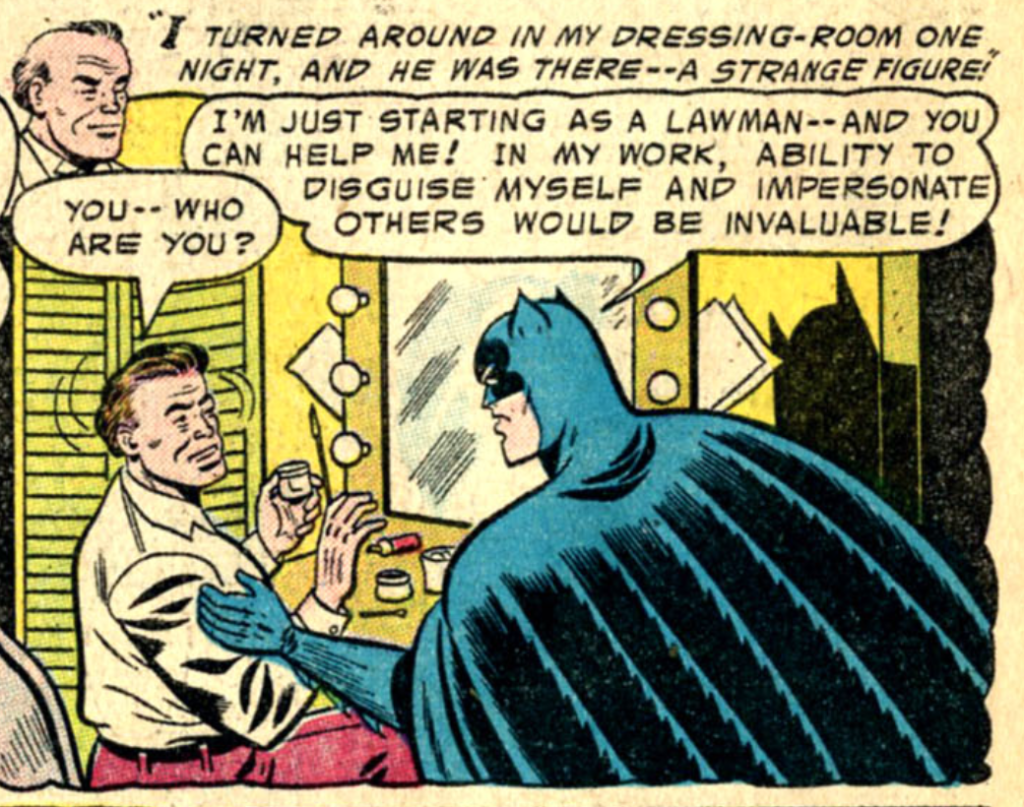
Detective Comics #227 by Sheldon Moldoff & Charles Paris (1956)
–FLASHBACK: From Detective Comics #227. Batman, back to wearing his gauntlet-fin gloves, begins training with Barrett Kean, master of makeup and disguise. While not specifically shown on our timeline, we must imagine a series of disguise lessons that occur over the course of the next few weeks.
–FLASHBACK: From Detective Comics #65. Batman goes after two bandits named Mike Nolan and Nick Rocco. Rocco betrays his partner and shoots him dead before escaping. Writer Joe Greene says that this flashback takes place “five years ago in 1937.” When Greene wrote this issue of ‘tec it was indeed 1942, but why he would draft a flashback to 1937, which is two years before Batman even debuted, is beyond me. He must have meant 1939.
–FLASHBACK: From Detective Comics #234 and World’s Finest Comics #65. Batman introduces himself to Commissioner Gordon. Gordon, while remaining cordial and friendly, summarily dismisses Batman and implies that amateur vigilante methods are too dangerous and unnecessary for Gotham. Batman will soon be placed on the GCPD’s most wanted list.
–REFERENCE: In Detective Comics #34. Bruce befriends someone named Jed Farnol.
–REFERENCE: In Batman #69 Part 2. Bruce (as both Bruce and Batman) joins Gotham City’s volunteer fire squad. The squad is led by Jim Garth and has over a dozen members, including actor Roger Lyons, millionaire Edgar Mead, reformed crook Albert Starr, zoo vet Wilber Frost, and lawyer Harry Dore. Obviously, the fire department has different more accepting views on Batman than the police department does. Batman and the squad will deal with a few fires over the course of the next few weeks.
–REFERENCE: In Batman #48 Part 2. June, 1939. Batman solves the “Venice Murder Case” and collects a gondola as a trophy. Since I’m fairly certain the “Venice Murder Case” is not from an actual written story, I’m not sure who the villain was or if Batman actually traveled to Italy—it could have been Little Italy in Gotham.
–Detective Comics #28-29
Batman, clearly still having issues with his gauntlet-fin gloves, decides to venture out without wearing any gloves at all. The bare-knuckled Batman shuts down a gang of jewel thieves led by the monocled Frenchy Blake. After being linked to the criminals by mistaken policemen, Batman defeats Blake’s whole gang and gets a signed confession out of Blake by hanging him upside-down out of a skyscraper window. This torture method will become one of Batman’s signature moves, moving forward. Batman then drops off Blake at police headquarters with another Bat-note attached to the villain. Detective Comics #28 is also notable because the Dark Knight debuts the use of a Bat-rope that he conceals within his utility belt. (Note that, the Caped Crusader is very obsessed with his motif. He will add a “Bat” prefix to the name of just about every weapon, tool, or vehicle he uses in his crime-fighting mission.)
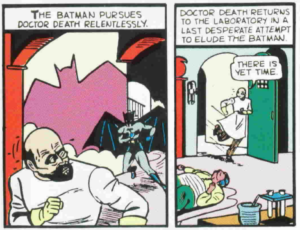
Detective Comics #29 by Gardner Fox & Bob Kane (1939)
After nabbing Frenchy Blake, Batman messes with his glove situation yet again, switching to small blue gloves. (He’s very finicky about his gloves, isn’t he?) Batman then meets his first ever super-villain, Karl Hellfern, better known as Doctor Death! It’s a pretty sure bet that if you wear a monocle in 1939 you are evil. Doctor Death, a chemical mastermind, sends a message to Batman in the personal ads of The Daily Globe telling him to pick up a letter at a specific post office. I’m not sure how this works since anybody can read the newspaper and, thus, anybody could show up to collect the message. But gaping plot hole aside, Bruce receives the letter, which brags about a murder that will be committed in a downtown penthouse. Batman then grabs one of his costumes out of the trunk in his bedroom. He suits up, wearing gloves and knee pads with suction cups. Using these cups to scale the tower, Batman is attacked and takes a bullet courtesy of Doctor Death’s main henchman, the behemoth Indian bodyguard Jabah. After narrowly escaping the building, Bruce is patched up by the Wayne family doctor. (Bruce makes up a cockamamie story about accidentally shooting himself and the skeptical doc doesn’t buy it for a minute.) The next day Bruce spots Jabah on an errand to execute someone on behalf of his master. Bruce saves the would-be victim and trails Jabah back to Doctor Death’s HQ. That night Batman infiltrates Doctor Death’s mansion and engages him in a battle that results in the torching of the entire building and the apparent death of the super-villain. Of course, unknown to Batman, Doctor Death survives. Detective Comics #29 is also notable because Batman debuts the use of “choking gas” smoke pellets/smoke bombs.[2]
–REFERENCE: In Detective Comics #33. Having recently been shot in ‘tec #28, Batman decides to wear a bulletproof vest from this point forward. Although, the Dark Knight will soon abandon the vest, finding it cumbersome.
–REFERENCE: In Batman #69 Part 2. Ironically and tragically, Batman and the volunteer fire squad are unable to put out a fire at the home of its leader Jim Garth. Garth is badly burned but survives. However, his entire family is killed.
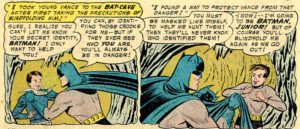
Detective Comics #231 by Edmond Hamilton, Sheldon Moldoff, & Charles Paris (1956)
–FLASHBACK: From Detective Comics #231. Batman—once again trying out his gauntlet-fin gloves—chases after bank robbers. But when a young boy named John Vance gets caught in the middle, the robbers flee, vowing to kill Vance since he is the only witness to the crime. Batman brings Vance, who happens to be a gifted child athlete, back to the Batcave (which should correctly read Bat-Bunker since Batman wouldn’t be calling it that yet[3]) and gives him a mini version of the Bat-costume. Batman and Batman Junior hit the streets and take down the bank robbers, a group led by Birrel Binter. Binter is sentenced to a long jail term but vows to get revenge one day. Batman Junior retires after this single mission, but Batman will keep constant track of Vance’s whereabouts for the next two decades.
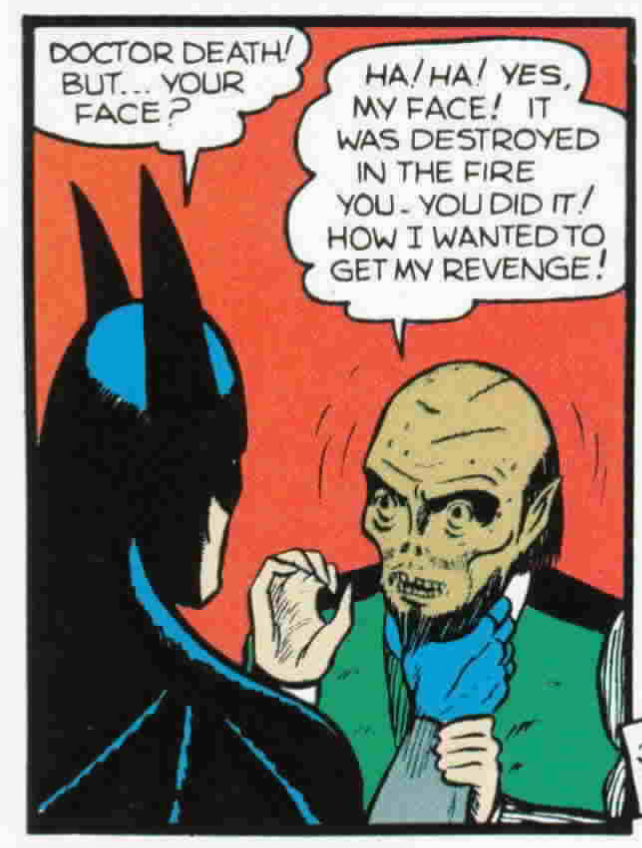
Detective Comics #30 by Gardner Fox, Bob Kane, & Sheldon Moldoff (1939)
–Detective Comics #30
Less than a week after the supposed demise of Doctor Death, the badly burned and heavily bandaged super-villain returns! After reading of a mysterious chemical death that resembles Doctor Death’s MO in the paper, Bruce decides to investigate by visiting the bereaved wife of the victim. She tells Bruce that she and her husband were indeed threatened by Doctor Death, who was after their diamond collection. Bruce then suits up as Batman—switching back to his small blue gloves—and waits by the diamond safe for Doctor Death to make a move. Doctor Death sends his new henchman, the Cossack brute Mikhail, to retrieve the loot. The Dark Knight trails Mikhail to a pawn shop where Mikail drops the diamonds. Batman then follows Mikhail to his apartment where they fight and the latter winds up with a broken neck! Batman then returns to the pawn shop only to discover that the pawn broker is actually Doctor Death in disguise. The Caped Crusader easily defeats him and leaves him for the cops.
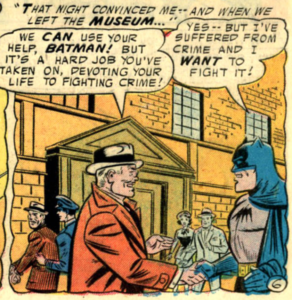
Detective Comics #234 by Edmond Hamilton, Sheldon Moldoff, & Stan Kaye (1956)
–FLASHBACK: From Detective Comics #234. Commissioner Gordon brokers a truce between the GCPD and Batman—(up to this point the GCPD has been under strict orders to arrest Batman)—in order to bring the Dark Knight along on a robbery case at the Museum of Time. Gordon wants to observe the Caped Crusader’s detective abilities in person. Batman—switched back to his gauntlet-fin glove look—catches the crook and finally earns the respect of Gordon. Bear in mind, even though there are a few other cops present at the Museum of Time case (and Gordon shakes Batman’s hand in view of several passers-by), the Commissioner’s endorsement of the Dark Knight is a private/unofficial one. Gordon won’t publicly/officially endorse Batman for another two years. Thus, Batman (and later Robin) will still be considered illegal vigilantes and will continue to be hunted down by the cops. (Gordon himself will flip-flop on his feelings toward Batman in these first few years. For example, early next year, in the intro to ‘tec #35, Gordon will discuss wanting to “catch” Batman.)
–FLASHBACK: From World’s Finest Comics #65. Commissioner Gordon continues to analyze the crime-fighting methodology of Batman. Batman helps Gordon solve a tough murder case and convict a man named Smith. Again, as stated above, don’t forget Gordon’s endorsement of the Dark Knight is private. He won’t publicly endorse Batman until Bat Year Three.
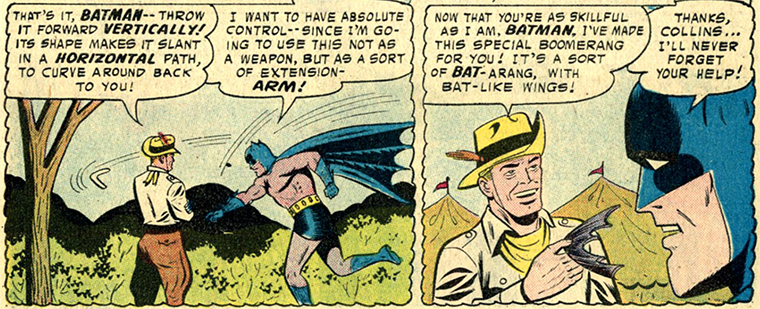
Detective Comics #244 by Bill Finger, Sheldon Moldoff, & Charles Paris (1957)
–FLASHBACK: From Detective Comics #244. Batman chases the gangster known as Bard into a circus. Australian boomerang expert Lee Collins, on tour with the circus, helps the Dark Knight capture Bard by deftly tossing his aboriginal weapon at the villain. Afterward, Collins trains Batman in the art of the boomerang and even constructs him a bat wing-shaped Batarang as a gift. Thus, the debut of the first ever Batarang! Afterward, Batman keeps the original Batarang as a trophy for the Hall of Trophies and begins producing more to use on regular patrol (as referenced in Detective Comics #244).
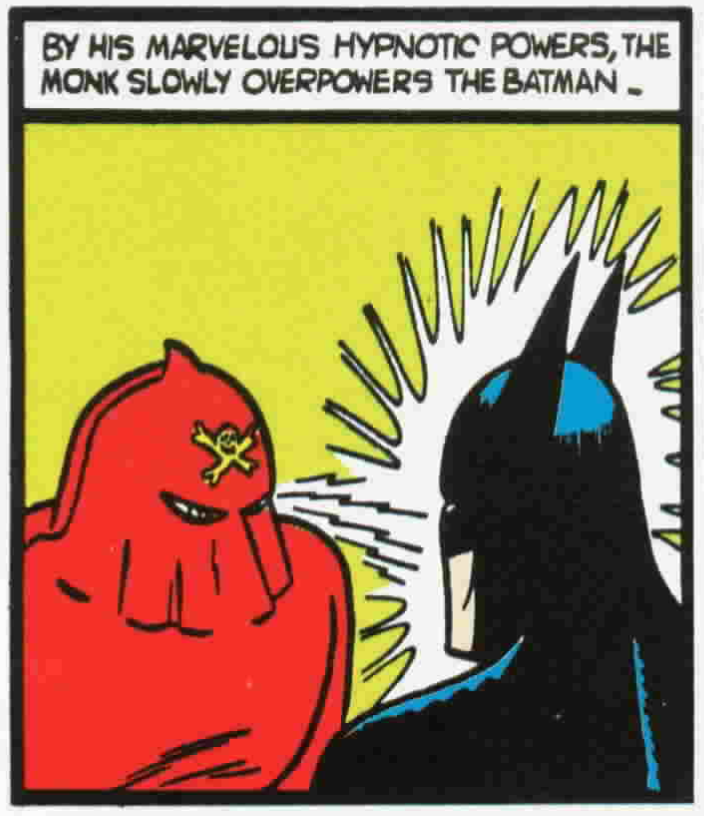
Detective Comics #32 by Gardner Fox, Bob Kane, & Sheldon Moldoff (1939)
–Detective Comics #31-32 (“BATMAN VS THE VAMPIRE”)
Bruce makes another visit to see Julie in New York, where she is still acting on a Broadway show. Julie, while under a hypnotic spell, tries to murder somebody! Bruce takes her to a quack therapist who recommends a relaxing trip to “the land of werewolves” aka Hungary. Bruce and Julie depart on a ship overseas. When Julie goes into another hypnotic trance Bruce discovers that the hooded super-villain known as The Monk is responsible. Bruce immediately dons his Batman costume—now with a brand new pair of gauntlet gloves that don’t have fins. The Caped Crusader fights the Monk aboard the ship. Batman chases the Monk to his HQ in Paris where the former falls into a trap and fights a colossal gorilla. The Monk escapes again, this time to his castle in his native Hungary. With Julie safely in a hotel in Paris, Batman debuts the Batgyro and flies to Hungary to go after the Monk. After attacking one of the Monk’s stagecoaches Batman apprehends his sexy servant Dala (aka Dala Vadim), who turns out to be a vampire! Batman drags Dala to the Monk’s castle only to learn that the Monk is also a vampire, who not only has the powers of hypnotism, but can turn into a werewolf as well. The Monk easily dispatches Batman into a pit full of werewolves, but the Dark Knight is able to escape. When the morning sun rises, the Caped Crusader finds the Monk and Dala sleeping in their coffins and kills them both with a gun loaded with silver bullets. “Batman vs The Vampire” is also notable because Batman uses the Batarang in action for the first time—although it’s misspelled “Baterang.” I should also mention that writer Gardner Fox reveals that Batman’s hometown is New York. Of course, this was later retconned to Gotham City.[4]
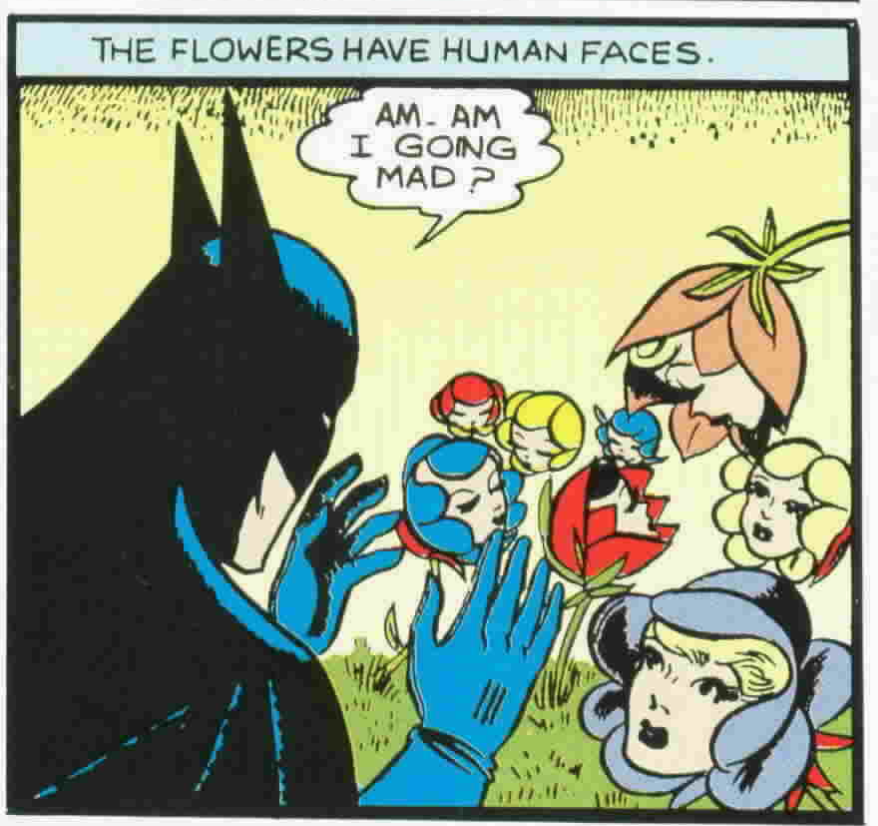
Detective Comics #34 by Gardner Fox, Bob Kane, & Sheldon Moldoff (1939)
–Detective Comics #34
This story takes place right after “Batman vs The Vampire” concludes, therefore ‘tec #34 is before ‘tec #33. Batman, who has just killed the Monk and Dala Vadim, returns to Julie at their Paris hotel. In Paris, Bruce comes across a man named Charles Maire, who is terrifyingly missing his face (à la Faceless Redrum or The Question). Maire explains that Duc D’Orterre, former leader of the Apache gang, had coveted his (Maire’s) sister. When she refused him, D’Orterre burned Maire’s face off with a sci-fi ray gun. Bruce dons the cape and cowl and goes after D’Orterre to obtain revenge on Maire’s behalf. At D’Orterre’s mansion Batman is captured and forced to undergo the pain of a giant spinning wheel torture device and a room full of bizarre anthropomorphic talking flowers. Yeah, not quite sure what to make of that one. After Batman escapes, he tracks down D’Orterre. The wily villain winds up dying in a car crash while struggling with the Dark Knight.
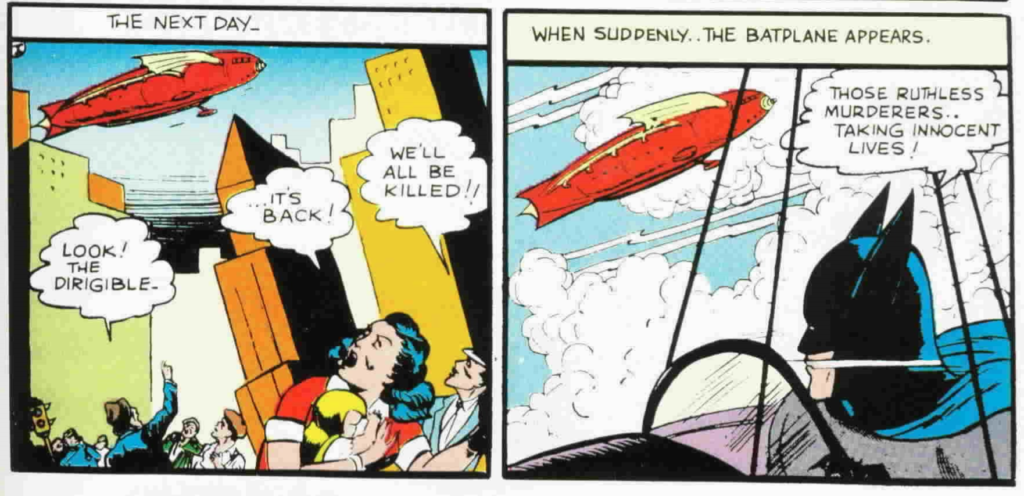
Detective Comics #33 by Bill Finger, Gardner Fox, Bob Kane, & Sheldon Moldoff (1939)
–Detective Comics #33
When the Dirigible of Doom floats high above Gotham and uses a death ray to destroy buildings, thousands perish. An angry Batman dons new gauntlet gloves (sans fins) that have claws attached to them. The Dark Knight goes after the owner of the blimp, the self-styled Napoleon, Dr. Carl Kruger. Batman tackles Kruger, his lieutenants, and his small army known as the Scarlet Horde head-on and nearly gets killed in the process. Batman later tries to sabotage the dirigible and almost dies again, taking a bullet in the back and losing a lot of blood, but surviving thanks to a bulletproof vest. The Dark Knight then comes up with one final plan that involves reinforcing the Batgyro and a kamikaze run into the dirigible. The Caped Crusader parachutes to safety. Kruger is spared from the destruction of the dirigible only to fatally crash his escape plane into the river while trying to mow down Batman.
–FLASHBACK: From Detective Comics #38, Batman #32 Part 2, Detective Comics #190, Star Spangled Comics #114, World’s Finest Comics #65, and Infinity Inc #6. Bruce decides to visit Haly’s Circus. At the show Bruce watches in horror as John Grayson and Mary Grayson, the trapeze artists known as the Flying Graysons, fall to their grisly deaths in an “accident” orchestrated by gangsters Tony Zucco and Blade. Their eight-year-old daredevil son Dick Grayson is left orphaned.[5] Feeling that Dick is a kindred spirit and wanting to help the boy avenge his parents’ deaths, Batman takes him under his wing and reveals his secret identity to him. Dick swears an oath to uphold the vigilante effort at all costs and begins an intensive training program that lasts “many months.” Dick’s training is intensive and includes both physical and classroom education. As part of the training, Bruce takes Dick to the public library as well (as referenced in Detective Comics #106). Bruce also legally adopts Dick as his ward. (While not addressed in any comics, Bruce and Julie presumably have a very long talk about bringing a child into their lives. At this juncture, with Bruce set to essentially become Dick’s new father, the idea certainly would be for Julie, as Bruce’s fiancée, to be Dick’s new mother.) Bruce and Dick will live in both Wayne Manor, just outside Gotham, and in a downtown apartment. We won’t see Dick again until his training is complete, but we must assume that the training is intense and occurs whenever Bruce has time. An interesting aside about Dick’s development: Martial arts are a big part of his training, but they don’t come naturally to Dick, who will rely more on his brains, acrobatics, detective skills, and gadgetry when fighting crime. For instance, as referenced in Justice League of America #123, we learn that Dick still hasn’t quite perfected his karate skills even by the time he in his mid 40s. Sure, thanks to being under the tutelage of a master like Batman, Dick will be better than the average fighter, but he won’t ever reach that true top tier level.
–REFERENCE: In Detective Comics #119. Now that Bruce has adopted Dick, he indoctrinates him into the new life of luxury that goes along with being a millionaire socialite. Dick will get a hefty cash allowance every month, to spend however he so chooses.
–REFERENCE: In Detective Comics #42, Batman #5 Part 4, and Batman #19 Part 4. Bruce joins a number of elite (and exclusive) clubs and attends socialite parties in a targeted effort to bolster and pump-up his effete rich-boy persona (as a way of distancing his secret ID from Batman as much a possible). At one of these club parties, Bruce meets and befriends wealthy socialites Linda Page, Ronnie Tower, Carol Tower, Judge Tower, Howard Prescott, Miles Rockley, and Reginald Van Astor. Bruce will attend many social gatherings that we’ll simply have to imagine as occurring randomly throughout our timeline ahead.
–REFERENCE: In Batman #54 Part 1. Bruce joins the exclusive Hobby Horse Club, meeting steward Charles and fellow members CC Weede, Jennings, Jim Gade, and Cyrus Peters.
–REFERENCE: In Batman #15 Part 4. Bruce joins the exclusive Crane Club, meeting neglected old doorman Ben Botts.
–REFERENCE: In World’s Finest Comics #57. Bruce joins the exclusive Court Club, meeting fellow members Spotswood Hartley and Arrington.
–REFERENCE: In Detective Comics #51. Bruce befriends circus owner Colonel Dawes.
–REFERENCE: In World’s Finest Comics #2. Bruce befriends prosecutor William Kendrick.
–REFERENCE: In Batman #7 Part 2. Bruce befriends Carl Dwyer.
–REFERENCE: In Batman #7 Part 3. Bruce befriends socialite Nora Powell.
–REFERENCE: In Batman #14 Part 1. Batman meets Dana Drye, one of the world’s greatest detectives.
–REFERENCE: In World’s Finest Comics #39. Bruce becomes a member at a local gym/health spa.
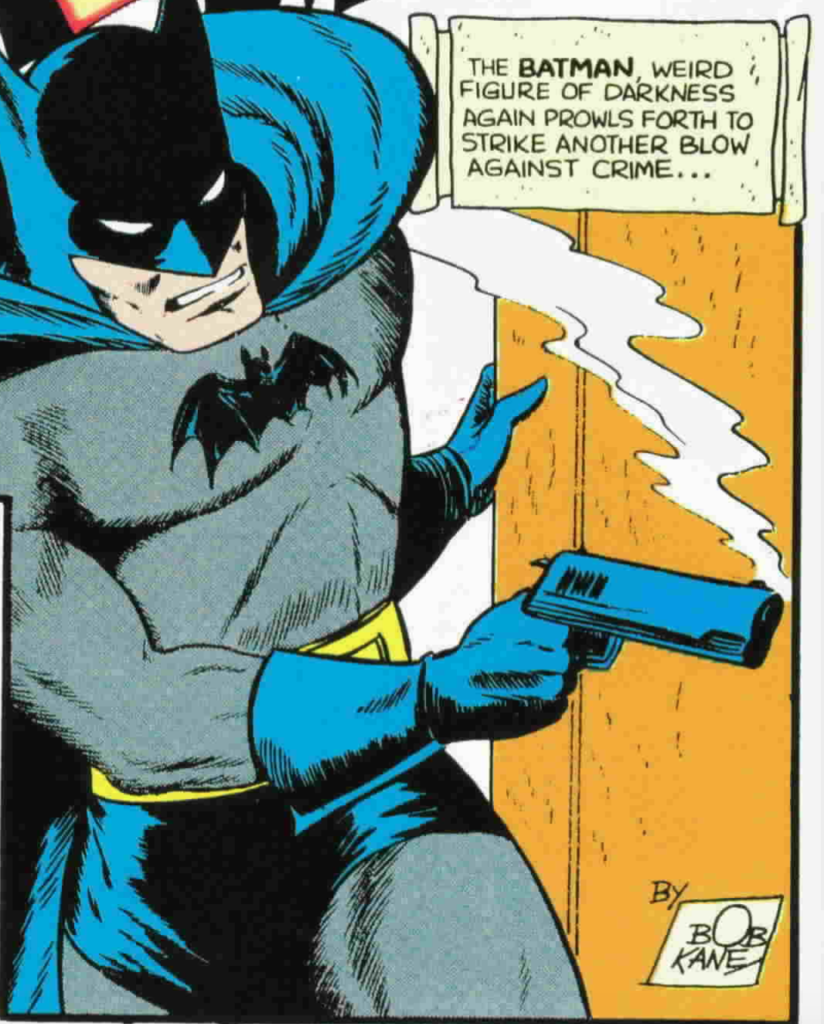
Detective Comics #35 by Bill Finger, Bob Kane, & Sheldon Moldoff (1940)
–FLASHBACK: From Detective Comics #35—and referenced in America vs The Justice Society #1. Batman used his personal handgun in Detective Comics #33 to blow up some ray machines, but prior to this had not actually shot anyone besides the vampires in Detective Comics #32. However, Detective Comics #35 shows an opening splash page with Batman—having switched back to regular gauntlet gloves (sans claws or fins)—holding his smoking handgun. Admittedly, the opening splashes, like covers, are never usually canon. However, a flashback from America vs The Justice Society #1 shows Batman in 1940 swinging down upon two criminals with a gun in his hand, mirroring and canonizing the ‘tec #35 splash that occurs here and now. America vs The Justice Society #1 also specifically mentions that Batman uses a gun in 1939 and 1940. (Thus, the America vs The Justice Society #1 reference gets attached here in 1939 while the America vs The Justice Society #1 flashback goes next year.)
_______________________________
_______________________________________________________________________________________
_______________________________
<<<PREVIOUS: EARLY YEARS<<< | >>>NEXT: YEAR TWO>>>
- [1]COLLIN COLSHER: Some sources list Bruce’s age when he graduates college as 21-years-old. However, America vs The Justice Society #1 shows us that Bruce was born in 1915. Thus, Bruce should be 24 at this point (having turned 24 on April 7, 1939).↩
- [2]DEFINITIVEWILL G (WILL GILLIES): In regard to his mastery of chemistry and production of smoke bombs, there’s no way Batman would not have come across the 1933 ten-volume book series entitled Chemical Formulary.↩
- [3]COLLIN COLSHER: For some, Detective Comics #231 is hard to rationalize on the Earth-2 timeline because it is written in 1956 (two years after Showcase #4, which debuts the proto-concept of Earth-1 and 2) yet still flashes-back to a Year One where there exists a Batcave and modern Batmobile. However, there is absolutely no way to prove that Edmond Hamilton and Sheldon Moldoff ever had any intention of writing this story for a new Batman on a new Earth in 1956. In fact, the much more Bat-authoritative Bill Finger and Dick Sprang made the same continuity error as far back as 1945!↩
- [4]PAPA SPANK!: Batman’s hometown being New York is indeed later retconned to Gotham. However, ‘tec #31 still takes place in New York. Secret Origins Vol. 2 #6 Part 1 establishes that Julie Madison was performing in New York and that Bruce made visits to her. We can safely assume that ‘tec #31 takes place during one of those visits.↩
- [5]COLLIN COLSHER: Determining Dick Grayson’s age is a tough one. The comics are notoriously confusing when it comes to Robin’s age—from the 1940s into the 21st century. The Last Days of the Justice Society Special #1 shows Dick’s gravestone, which says he was born in 1928 and died in 1985. This would seemingly make him eleven-years-old (going on twelve) at the time of his debut here in Year One. However, Dick seems to graduate high school around 1951 (later really, but we can safely push things to 1951 at the earliest). If he is 11-years-old right now, then he’d be around 23-years-old when he graduates. This seems wrong. Retconning his age to eight-years-old in Year One makes him 20-years-old at graduation, which is still a stretch, but at least it makes a little more sense since he would have been delayed due to missing a lot of school days due to his secret life as a crimefighter. Thus, Dick’s birth year should be 1931 instead of 1928. If you are looking for an in-story fanwank to explain this difference, there isn’t one, although perhaps the events of Crisis (or some other cosmic event) distort Dick’s age/birthdate.↩

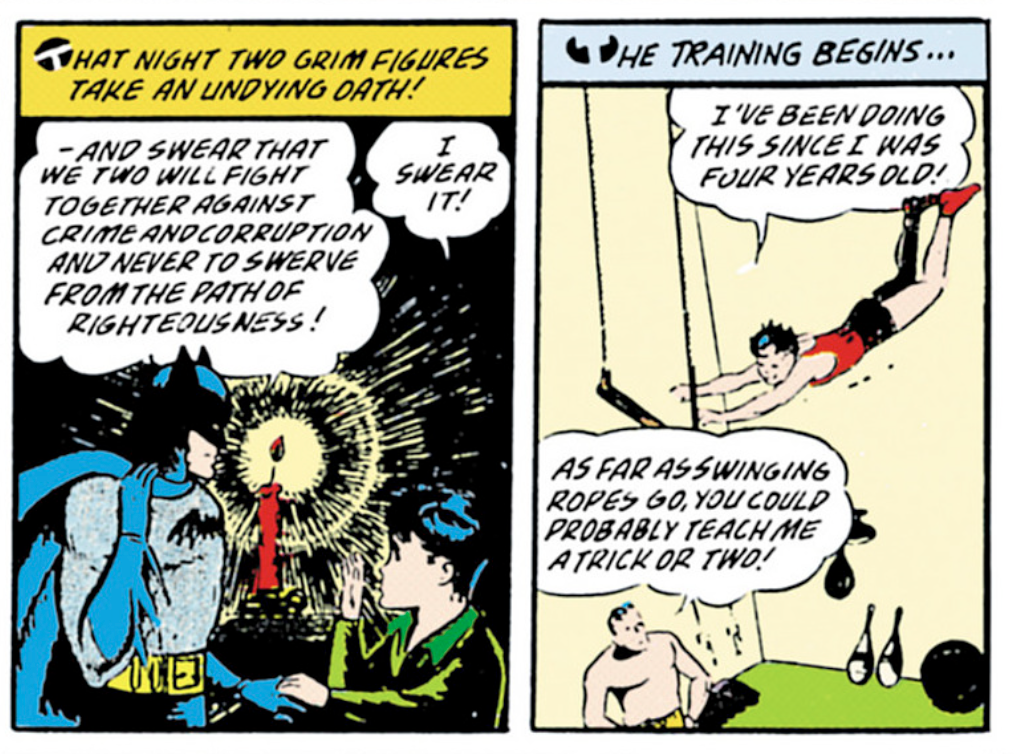


So, along with Detective Comics #38, Batman #32 Part 2, and Infinity Inc #6, a (rather-good) flashback of Robin’s origins appears in “Robin – Boy Acrobat!” from Star Spangled Comics #114. From his parents being murdered and first meeting Batman, it seems fitting enough that it should be listed as well.
Can’t believe I just found out about this site a little over a week ago. I’m stunned. I’ve always wanted to dedicate my time to organizing something like this, but you beat me to it. But I really wish you had a Salad Days section for the Golden Age. There’s a Golden Age timeline out there, but it’s not nearly as detailed as the ones on your site.
For what it’s worth though, I did see some minor errors. In the Golden Age, the date of the Wayne murders is June 26, as established in Secret Origins #6, which specifies the origin story as being the one of the Golden Age/Earth-2 Batman specifically. Detective Comics #265, which says the date is November 25, was published in 1959, which was during the Silver Age of DC Comics (mid-1950’s-late 1960’s). Although some say the Silver Age started with Flash’s 1st 1956 appearance, it was initially supposed to start with the introduction of Martian Manhunter in 1955, who I believe was the 1st hero to be introduced in the Silver Age (if I recall correctly). So yeah, keep up the good work!
Hey Anthony! So glad you found us! If I may ask, how did you stumble upon the project? I’m always looking to reach a wider audience.
To respond to your comment: If I’m not mistaken, there isn’t a specific date in Secret Origins, merely the year 1924. Correct me if I’m wrong though! What page does it say June 26? I know June 26 is mentioned in Batman Special #1 (1984), Batman #408 (1987), and The Batman Files (2011), but I hadn’t seen it anywhere else.
And Secret Origins Vol. 2 #6 itself was partially based on/flashes back to Detective Comics #265, among other tales, which makes Detective Comics #265, despite its publication date, definitively an Earth-2 tale. Due to retcons in the 1970s and 1980s, a handful of stories published in the Silver Age are actually Earth-2 stories, continuing the Golden Age narrative. IN ANY CASE, I also don’t see any specific reference to any date at all in ‘tec #265 either! I submit to you that NO Golden Age comic EVER attached a date to the Wayne deaths.
To get back to what I was saying before, though… The idea that the Silver Age starts with Martian Manhunter in 1955 instead of Flash in 1956 is a fairly common misconception. Regarding Martian Manhunter, in my opinion, which is shared by historian Craig Shutt, J’onn J’onzz is actually a late debuting Golden Age hero. There’s no hint of Martian Manhunter being on an alternate Earth, not until Detective Comics #273 (November 1959), where his character makes a noticeable personality shift. In stark contrast, Flash’s tale from Showcase #4 was an alternate Earth story completely and definitively. (Barry reading Jay Garrick comics undeniably set his world on a different Earth—the prerequisite to understanding this being the fact that the Shazam/Marvel Family home was an alternate Earth seen as fictional comics as well.)
But let me know what you think. I’m always trying to improve the site, so it’s nice to have a fresh set of eyes. And I wish I had done a Golden Salad Days section too. Maybe one day!
Also, my methodology in regard to the start of the Silver Age is very specific and at times contradictory to other sources, usually less well-researched sources, on the web or in historical texts. See https://therealbatmanchronologyproject.com/thesilverage/ for excruciating details. The Silver Age doesn’t have an exact start date for the entire line. It’s staggered depending on character. If we really dig deep and look into Batman solely, his Silver Age (barring a handful of stories that become exceptions due to 1970s and 1980s retcons) doesn’t begin proper until 1960. Hence, Detective Comics #265 is a tried-and-true Golden Age (Earth-2) tale even if it is mixed among fledgling Silver Age (Earth-1) tales.
But you’ve reminded me that this info would serve well on the Golden Age part of the site, so I will add a note. Thanks!
Ah, I see. To be honest, I got a lot of the Golden-Age info from another site: https://www.cosmicteams.com/jsa/batman/batman_chron-1.htm It tries to list events from The Golden Age in chronological order (including its own Salad Days-type section). I would actually recommend looking at it for your reference. But to answer your 1st question, I was actually looking to see if there was a definitive, comprehensive timeline for Batman’s origin story and stumbled upon your website (which I’m so glad I did). Also, glad I could help provide info!
Also, was there ever a comic where Jim Gordon was actually at the crime scene of the Wayne murders? I remember you listed that as an event, but it was only a reference. I’m wondering if there was a flashback at any point in time before Gotham came around. I’ve tried researching myself, but clearly you’re the more superior bat-fan and have more knowledge than I do, so I figured I should pick your brain about it. Thank you in advance.
I couldn’t have done my site without the aid of Cosmic Teams, and I 100% cribbed from this very page you’ve linked on numerous occasions to help me keep things straight.
I think the first time we see Gordon actually physically at the Wayne crime scene isn’t until Batman Inc Vol. 2 #13 (2013) by Grant Morrison. And this was taken from the Christopher Nolan movies if i’m not mistaken.
Thanks. I’ll be sure to check it out. I know this would be a lot more work, but I think it would be neat to have pictures of the panels from the comics accompanying the events on the timelines. That way we could see where you got the references from. But yeah, all this has been really helpful. Wish I had found this sooner. It would’ve really saved me a lot of time from scrounging around through everything to find all the events I was looking for.
Haha, my brother was just viewing my site the other day and was like, “I love this, but it’s an endless wall of text. Pictures or I’m bored, please.” He’s not wrong. Hopefully, some day soon!
I would actually be willing to acquire some clippings of some scans to send to you. If you could just tell me which page numbers. I look through the sources you put before every event, but can’t seem to find the specific pages with the info on it. Anything I can do to help!
I have access to just about all the scans I’d need, so that’s not the issue. Issue is time and prioritization. My immediate goal for 2020 is to complete the Silver Age (currently reading 1981 publications, heading to the end in 1986) then tackle aesthetics. But once I do, I might just call upon you for assistance. Biggest help would be putting together a Golden Age Salad Days and/or New 52 Salad Days. I neglected to do those both and it’s a bit of a regret. Believe it or not, I didn’t do a Salad Days for the Modern Age when I started, but a follower Martin Lel stepped up to the plate big time and created one, which I then edited and added to the site.
Thanks for following the site—that’s the biggest help of all, simply being a patron.
Yeah. That’s what I meant. I figured it was a time issue, and I’m not usually very busy, so I feel like I could scan through some stuff. I might need some page numbers though. Looking for Golden Age should be easy. New 52 might be a bit of a challenge but I’m definitely up for it. I could possibly exchange emails if interested.
Hey, I sent you an email earlier. Did you receive any notification or did I type in the email wrong? I tried sending a condensed version of the Golden Age Pre-Batman timeline from the site I had linked. Hope it didn’t get trashed. Thank you in advance for checking. 🙂
Shouldn’t Dick be eleven during year one and not eight, since in Last Days of the Justice Society Special #1 Dick’s gravestone lists that he was born in 1928 and died in 1985.
This is a tough one. The comics are ROUGH when it comes to Robin’s age—from the Golden Age through today. Dick seems to graduate high school around 1951 (later really, but we can push things to 1951 at the earliest). If he is 11-years-old in Year One, then he’d be around 23-years-old when he graduates. This seems wrong. Pushing his age to 8-years-old in Year One makes him 20-years-old at graduation, still a stretch, but at least it makes a little more sense since he would have been delayed due to missing a lot of school days due to his secret life as Robin.
Well. This site is everything I needed to put my Batman Collection in irdere
Hi Colin. I wrote this comment in the quick list, it was a mistake. I wanted to put it here. I was reading Generations #1, then I read D.C.#1027 and watched the episode dedicated to Batman. Here a salesman has a newspaper where we read that Hitler has conquered Poland on october 6. Skeets says that Bats has only been a vigilante for days. Is this a reboot? Does the new debut of Batman of the Golden Age happen in the first week of October 1939?
Hi Diego, I accidentally read that headline as “Poland Invaded by Germany” (which would mean a September 1 or 2, 1939 headline) but yes it does clearly say “Poland Falls to Germany” (which would mean an October 6 or 7, 1939 headline). But it’s a mistake to think that anything written in 2021 has any effect upon continuity from decades prior. (Unknotted or not, I could go through a long list of reasons why it’s simply not feasible from a narrative standpoint—which maybe I’ll do in a separate blog post.) In Generations (which let’s not forget is merely recycled unused 5G stuff), we aren’t seeing the Batman of the Golden Age, nor are we seeing THE ORIGINAL characters from different eras. It’s Hypertime, plain and simple. They merely mirror their older counterparts. Also, I have no idea how or why Batman “morphed into” the Golden Age-styled Batman. Hopefully, that gets explained.
DC went well out of its way to emphasize how Death Metal wasn’t a reboot (or was the anti-reboot, which is fancy way of saying “reboot but different”). And I guess they are correct for the most part.
Oh, that’s right. The concept of hypertime is an idea that I still find difficult to understand how it works. I will remember your appreciation in future readings. Thank you very much, my friend.
Hey, I really enjoy your timeline you obviously put a lot of thought into it.
one question I had however, was that you seem to have put a lot of story content between Detective comics 29 & 30 even though they take place “less than a week” apart.
wouldn’t it make sense to put some of it (particularly the Robin stuff, as thats quite a bit of plot development to take place over 3-6 days) after Detective 30? Possibly even after Detective 34 as then you would have to manage the question of “how does Julie Madison feel about her fiance randomly adopting an 8 year old orphan”?
Hello! I’ll bite one this. You make a good point about the weeklong gap there. The Death of the Flying Graysons definitely goes in Year One, but it could easily be slid post Detective Comics #33-34. And yes, I never thought about it before, but Bruce and Julie would def have to have had a talk about bringing a child into their lives, haha. Def worth mentioning. Thanks!
Obviously popping all over right now. Just some small mistakes I’ve noted, for both Jed Farnol and Colonel Dawes, the reference is one issue off. Farnol’s should be DC #34 and Dawes’ should be DC #51.
Also, for GA Year 2, your Skid Turkel flashback should be for Batman #74 Part 2, not one. Not sure if there was an error or something when you added these in, but there you go. I didn’t notice any other references not being right, but I didn’t look too deeply into them.
Thanks, James. Typos! I will fix. Much appreciated.